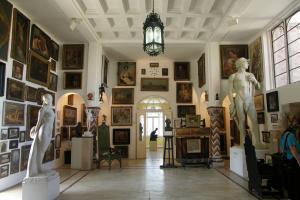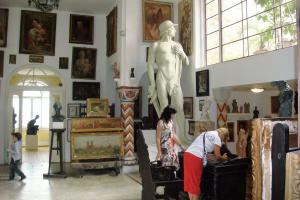Through a hall we arrive at the actual atelier. As we enter, the spacious room reveals itself under the coffered ceiling. No statues made here anymore and still what we see isn’t just an exhibition of pictures and statues but also the place is a memory, a museum of itself.
The most outstanding work of art is the Wounded Hero (1927). It is the original plaster model of the statue at the Technical University which was made for the memory of the soldiers killed in action in the First World War. The huge figure was casted in bronze in 2000, and this way the original one, which was moved in 1949 and its material was used to make the Stalin monument, was replaced.
Bory’s desk made in eclectic style and is richly carved, together with his armchair is near the huge moulding. Behind the desk, on the right of the big room the visitor can see old photos, writings, interesting family papers and official documents.
Almost all the walls are covered with pictures and some of them are displayed on easels. The portrait of Mrs Bory can be seen here. It was painted by Bertalan Székely (1835-1910) the famous historical painter, one of the founders of “Mintarajziskola” later College of Fine Arts, who was her teacher. Next to it, we see the portrait of the master Bertalan Székely painted by the young painter Ilona Komócsin, Mrs Bory (1885-1974). The collection contains several works of Bertalan Karlovszky (1858-1938) one of the most occupied limners of academic style. A genre painting called The Weekenders made by Ágoston Benkhard (1882-1961) a follower of the School of Nagybánya is displayed here. Peter Bory’s wedding in 1476 by Dezső Raksányi is also shown in this room.
And of course there are the statues mainly on postaments near the walls but some of them can be found on the ledges of the high windows.
To the left from the Wounded Hero in the room stands the figurative plaster statue of Architecture (1914) holding a plummet in his right hand and a mockup of the Heart of Jesus Church in Székesfehérvár in his left. Near to it is the Fairy of the Lake made in plaster, the aluminium version of which was displayed in Agárd in 1960 and a version of the early Kiss composition (1908). Also the kneeling Yearning (1929) in black pirobazalt, which won a silver price at the World Expo in Barcelona in 1929, and the portraits of Petőfi (1921) and Rembrandt (1921) made from the same material can be seen here. In the corner on the wall, above the portrait of Bory’s mother, we find the cast of Bishop Ottokár Prohászka’s hand.
Almost in the middle of the room, one of Bory’s most beautiful and very authentic, 19th century style bronze statuette of John the Baptizer (around 1920) is seen. This statuette stands also on the christening fountain of the Saint Miklós parish church in Muraszombat.
It is worth stepping out to the arcuate balcony from where there is a beautiful view to the garden and the terraces.




